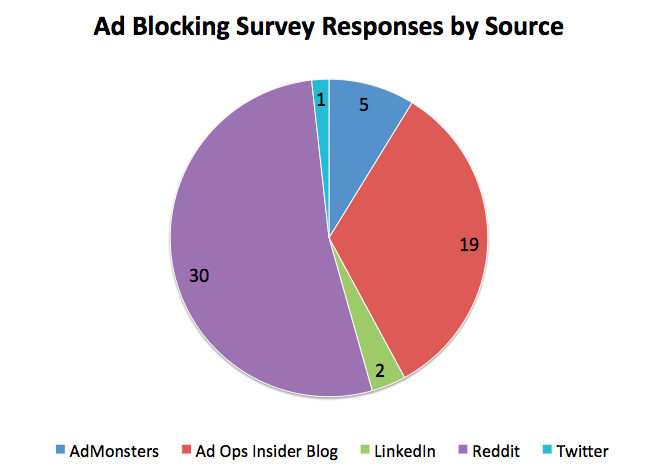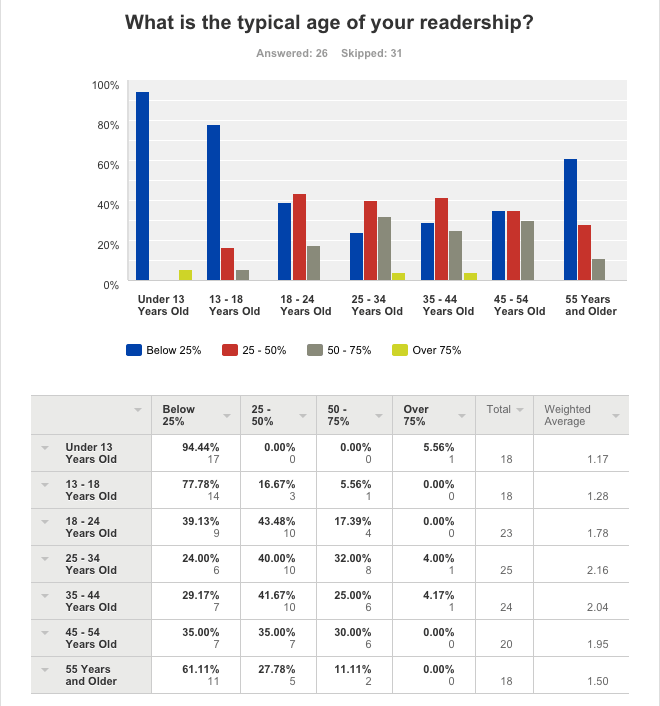Thanks to everyone who took the ad blocking survey last week! As promised, the results are posted below.
Ad Blocking Survey Design
There were 57 participants who took part in the survey over the course of ten days. I promoted the survey through various channels, including Twitter, LinkedIn, the Ad Ops subreddit, the AdMonsters forum, and naturally on this site. The survey itself was powered by SurveyMonkey. Here’s how it breaks down in terms of respondent referral source:

Because I also ran this survey as anonymous by design, I can’t make any statement about how many of these publishers are big, premium brands, and how many are smaller shops. That said, Ad Ops tends to be a community that serves larger publisher organizations so my expectation is that we’re looking at trends that reflect professional publisher organizations and not amateur shops.
Summary: Publishers Concerned, Ill-Prepared for Ad Blocking Impact
At best, the survey results show publishers are just starting to confront the issue of ad blocking; at worst, they show publishers as woefully unprepared and without much of a strategy. Here are the highlights:
- Only 50% of surveyed publishers are tracking their ad blocking rate, even though you don’t need any special software to do it
- Of those who track ad blocking, nearly 60% quote their blocked rate between 10 – 30%.
- 46% of publishers are “very” to “extremely” concerned about the impact ad blocking will have on their business.
- Across all respondents, only 16% said they planned to do nothing to cope with ad blocking
- Over 20% of publishers plan to use 3rd party software to circumvent ad blocking on their properties
- 35% of participants said they personally used an ad blocker
From these results we know that ad blocking is having a significant impact on both publishers’ business and psyche. Publishers are worried about ad blocking, they just don’t know what to do about it yet. In many ways the state of ad blocking today reminds me of the state of viewability last year when it felt as though many publishers were just getting their house in order on how they would track their viewability rates, what solution they would use to do it, and what their position would be on selling viewability guarantees to advertisers. And while the issue has since lost some urgency due to all the confusion around standards and measurability, in my opinion viewability proved how fast publishers could move on a big issue with major technical considerations.
Publishers are going to need that same kind of agility to confront ad blocking, which unlike viewability is unlikely to lose steam in the near future given the coming iOS release to support ad blocking apps, and the demise of Flash ads, causing a switch to the more secure but heavier HTML5 standard.
Ad Blocking Survey Detail
Here are all questions I asked on the survey, along with the aggregated responses.
To me, the chart above was one of the more shocking results in the survey; tracking ad blocking rates is not nearly as complex as tracking viewability, and given the rise of this trend in the market, it’s inexcusable for a publisher to ignore even measuring the trend.
Of the publishers that do track the rate of ad blocking, the world is fairly split on DIY-ers vs. those using a 3rd party solution. It’s not difficult to start tracking ad blocking in your analytics solution if you can add a small bit of JavaScript to your site; that’s what I did in Google Analytics and it was easy to add secondary dimensions like country or browser to see where most ad blocking occurred.
This is the key question I really wanted answered in this survey. I wasn’t quite sure what to expect with this question, as the well-shared PageFair study had quoted rates north of 30% for both Firefox and Chrome, but I had seen my own rate come in far lower (documented in the section below). I can see the survey by survey responses and when I look at how those that answered in the higher ranges for this question, they all also have a younger skewing audience.
As I mentioned in the summary note, these results surprised me a bit based on how many publishers weren’t tracking ad blocking rates at all. Since 50% of publishers aren’t tracking their rate, but only 16% aren’t worried at all, there are a number of publishers who are scared but don’t have any data to know where they stand. Time to get it in gear!
As you can see from the results above, no one has a clear plan on how to tackle ad blocking, and most are still in investigation mode. Of the 55 respondents, only 18 had an answer that didn’t include “nothing” or “something, but we’re not sure yet”. Of those 18, eleven selected only one option, five selected two options, and two selected three options. For the one option folks, five said they would ask users to whitelist their domain only, three said they would block users only, and three said they would look at software. For the two option folks, two mentioned whitelisting, three said they’d block users from content, four said they would offer a premium, ad free option, and one said they would use anti-ad blocking software, but there was no clear grouping. And for the three option folks, both respondents said they would take a more aggressive strategy and block users from content as well as use anti-ad block software, with one mentioning whitelisting and the other mentioning a premium option.
This was just for fun, but I was curious – how many people who work in the industry use an ad blocker? 35% is higher than all but three respondents said the rate was where they worked, but is more or less in-line with the PageFair benchmark. My own hope was that we’d see a low number here, as you’d hope people who know the inner workings of digital advertising would be less fearful of it, but given the number of people I’ve seen using ad blockers at work in my own life, the number doesn’t shock me either.
Virtually everyone who took the survey is selling display advertising. These results are somewhat difficult to interpret because users could submit multiple answers, but having looked through the detailed results, of the publishers that didn’t select display, one chose mobile app only, and the other chose video and mobile video. The most common selection by far was display and mobile web.
This final question was unfortunately added about halfway through the study, at the suggestion of /u/dbjobs/ on Reddit who thought there would likely be a correlation between ad blocking rates and audience age range. They turned out to be right from a data perspective, but the sample ended up being pretty small.
Ad Blocking on Ad Ops Insider
This survey is more than a professional interest for me, because I’m a publisher, too, albeit a small one. I started tracking ad blocking on Ad Ops Insider about a month ago and can share some stats with everyone on how I’m thinking about this issue for this site.
- Currently, the ad blocking rate on this site is 12.9%
- In the United States, about 11% of users block ads on the site, while in France the rate is nearly 30% – yikes!
- Browsers have a large impact on ad blocking rates – 15% of Chrome users use an ad blocker, compared with 13% of Firefox users, 5.7% of Safari users, and 2% of Internet Explorer users.
- I only plan to adopt passive anti-ad blocking asks on the readership of this site, like asking ad blockers to whitelist me – but that’s mainly because I don’t make a living from this site. If this was my full time gig I’d likely go the direction of a premium offering, which I think would work best for this site.
Ad Blocking in the News
There’s been quite a lot of press around the topic of ad blocking lately – if you haven’t been following it, here’s a quick digest of the major articles:
Ad Blocking Goes Mainstream (pdf) – by PageFair and Adobe – this is the most comprehensive research study I’ve seen to date around ad blocking, though some have questioned the legitimacy of the findings, given PageFair provides anti-ad blocking software
A blow for mobile advertising: The next version of Safari will let users block ads on iPhones and iPads – by Joshua Benton on NiemanLab – this was one of the first articles announcing Apple’s plans to allow ad blockers into the app store.
The rise of AdBlock reveals a serious problem in the advertising world – by Frédéric Filloux on Quartz – one of the better opinion pieces and overviews of why ad blocking is a rising factor online that I’ve read.
Adblocking And The End Of Big Advertising – by Danny Crichton on TechCrunch – I was highly critical of this article when it came out, but the fact is it’s well written and a good consumer point of view on how the advertising ecosystem pushed consumers towards ad blocking.
With Technology, Avoiding Both Ads and the Blockers – by Sydney Ember on the New York Times – many think ad blocking will further energize native advertising solutions and notes Allrecipes’ site redesign of a publisher trying to capitalize on that idea.
Ad Blocking Solutions
If you are a digital publisher and trying to get educated on the solutions out there, here are the vendors that provide services in the ad blocking realm.









Thank you for sharing your thoughts on this Ben. We have been reading your articles on the adtech ecosytem and have learned a lot. It seems to get more and more complex every year. Will be interesting to see where adblocking movement goes – we’ve seen tremendous demand for our accelerated ad-reinsertion product at Blockthrough.com, so it’s definitely more on the radar now than it was when this article was published.